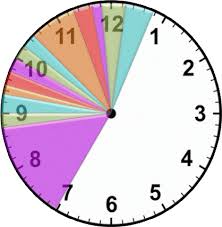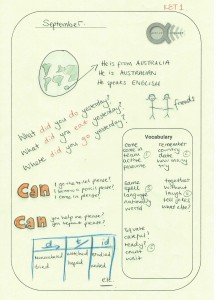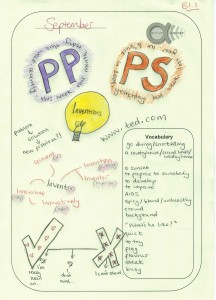As teachers we often talk about students “learning” and us “teaching” and while, of course, that’s our over-arching aim, the words themselves feel too big, too clunky to actually mean much on a day-to-day level in the classroom. It also helps us in our particular situations to aim high across the board (see Jim Scrivener et al on Demand High ELT).
When we plan classes I think it helps both us and our learners to be much more precise – what do we want our students to do with the language and how? Sometimes the material feels difficult for the students, sometimes too difficult. This is likely to be the case with our higher primary levels (M1, M2, F1) and our in-curricular exam familiarization classes in San Felipe Neri (in 1º – 4º ESO). Of course, if we’re constantly over-challenging students, their motivation and their attitude towards English is going to suffer and I would argue the same is true of constant under-challenge too. Hmm, it seems like a tricky balancing act. I hope to help a little here, I hope to lay out our expectations for these groups and I hope to allow us all to relax with the material, with the students and allow us all, learners and teachers alike, to enjoy ourselves.
Let’s start with the Footprints series, it’s a pretty high-level course for Primary. We made the switch a couple of years ago from the much-loved and lower level Bugs series, both series published by Macmillan. We found that the lower level books took the students comfortably up to the level and then we as teachers found it hard to go much beyond those levels. The Footprints series stretch the students and stretch us as teachers as we need to S.A.S. more. S.A.S. stands for Select, Adapt, Supplement – it’s about us as teachers looking critically at materials, thinking carefully about our students and plotting an appropriate course through it all. We tell parents very clearly that the books are a really great tool to help us all in the class and that we are not here to simply move through the pages ticking everything off and going through the motions. We tell parents clearly that we won’t do everything in the book so you shouldn’t feel obliged to do everything either. Having said this, it’s important that we use the book whenever we can and supplement when we need to, the parents have bought the books and we have a responsibility to use them as much as possible.
OK, let’s get back to aims, the older Primary students and “learning”. It is an error to think that our students in 5º Primaria, who have found their way into a Footprints 6 class, are going to “learn” first and second conditionals, passives, etc. To be honest, I only have a vague idea of what it really means to “learn” something, speaking as both an English teacher and Spanish learner. Let’s talk specifics and let’s talk planning aims; “expose students to”, “improve”, “use” and “play with” feel like much more appropriate aims than simply “learn”. Some of our students will pick it up perfectly from the word go, others will have a good idea, others a vague idea, others still will be totally lost. That’s OK, we have achieved our aims of “playing” or “exposing” and we will have moved students along in their learning. Don’t think you need for your students to “get it” before you move on. We need to balance this with the role of routines.
Routines in the primary classroom provide us with the space for students to see language again that they’ve been exposed to and played with before and to preview up coming language; it gives us space to review and preview. This is an essential job, if we’re not doing it, we’re not doing our job properly. Every lesson should contain a moment to revise language in a dynamic, engaging and evolving way (some examples include elicited character builds, question and answer games, disappearing words, etc – do ask if you’re not sure what these are). Routines are not about always doing the same thing again and again, they’re not about asking students every lesson to spell their name. Routines are there to constantly reinforce previously seen language, students will see it again and again in different ways and in different contexts. Routines are also an excellent way to expose students to new language in a comfortable way before we “study” it. Combining these things, who knows at some point they may even “learn” it! In routines we trust.
I’m aware that so far we’ve looked at specific language, really based around vocab and grammar, but what of skills? Skills classes should be planned as that, value the processes around all of the four skills; reading, writing, listening and speaking. Plan them as skills classes where the students are going to practise those specific skills. Do plan properly; think about pre-listening/reading moments, gist as well as detailed reading and listening activities, vocab work and a clear, chunky communicative moment at some point in the class. This is as true of our older primary classes as it is in the Cambridge exam familiarization classes at San Felipe Neri; students are likely to be dealing with texts that they’re uncomfortable with. Again, really, it’s the same message we should transmit to all our students; it’s about exposure and having a go. In our teenage classes, it’s likely to be about helping them learn from each other, remembering that teens learn more from their peers than they do from us, their paid teachers.
Hopefully this will give you some clear principles to develop and follow in your classes. Go beyond “learn” in your plans, make space for review and preview, help the students enjoy the challenge of higher level work. Aim high and keep your feet on the ground.
(As always, do fire away if you have any questions about this or anything else!)





